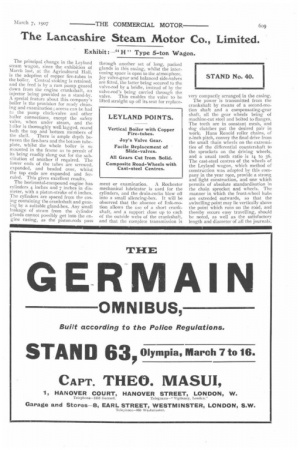The Lancashire Steam Motor Co., Limited.
Page 17

If you've noticed an error in this article please click here to report it so we can fix it.
Exhibit :—" H" Type 5-ton Wagon.
The principal change in the Leyland steam wagon, since the exhibition of March last, at the Agricultural Hall, is the adoption of copper fire-tubes in the boiler. Central stoking is retained, and the feed is by a ram pump geared down from the engine crankshaft, an injector being provided as a stand-by. A special feature about this company's boiler is the provision for ready cleaning and examination ; access can be had to the pump clack-valve and other boiler connections, except the safety valve, when under steam, and the toiler is thoroughly well lagged, round both the top and bottom members of the shell. There is ample depth between the fire-bars and the bottom tubeplate, whilst the whole boiler is so mounted in the frame as to permit of its being readily slung out for the substitution of another if required. The lower ends of the tubes are screwed, expanded, and beaded over, whilst the top ends are expanded and ferruled. This gives excellent results. The horizontal-compound engine has cylinders 4 inches and 7 inches in diameter, with a piston-stroke of 6 inches. The cylinders are spaced from the casing containing the crankshaft and gearing by a suitable gland-box. Any small leakage of steam from the cylinder glands cannot possibly get into the engine casing, as the piston-rods pass
through another set of long, packed glands in this casing, whilst the intervening space is open to the atmosphere. Joy valve-gear and balanced side-valves are fitted, the latter being secured to the valve-rod by a bridle, instead of by the valve-rod's being carried through the valve. This enables the valve to be lifted straight up off its seat for replace merit or examination. A Rochester mechanical lubricator is used for the cylinders, and the drain-cocks blow on into a small silencing-box. It will be observed that the absence of link-motion allows the use of a short crankshaft, and a support close up to each of the outside webs of the crankshaft, and that the complete transmission is very compactly arranged in the casing. The power is transmitted from the crankshaft by means of a second-motion shaft and a compensating-gear shaft, all the gear wheels being of machine-cut steel and bolted to flanges. The teeth are in constant mesh, and dog clutches put the desired pair in work. Hans Renold roller chains, of 2-inch pitch, convey the final drive from the small chain wheels on the extremities of the differential countershaft to the sprockets on the driving wheels, and a usual tooth ratio is 4 to 36. The cast-steel centres of the wheels of the Leyland wagon, which method of construction was adopted by this company in the year 1902, provide a strong and light construction, and one which permits of absolute standardisation in the chain sprocket and wheels. The manner in which the front-wheel hubs are extended outwards, so that the swivelling point may lie vertically above the point which runs on the road, and thereby secure easy travelling, should be noted, as well as the satisfactory length and diameter of all the journals.








































